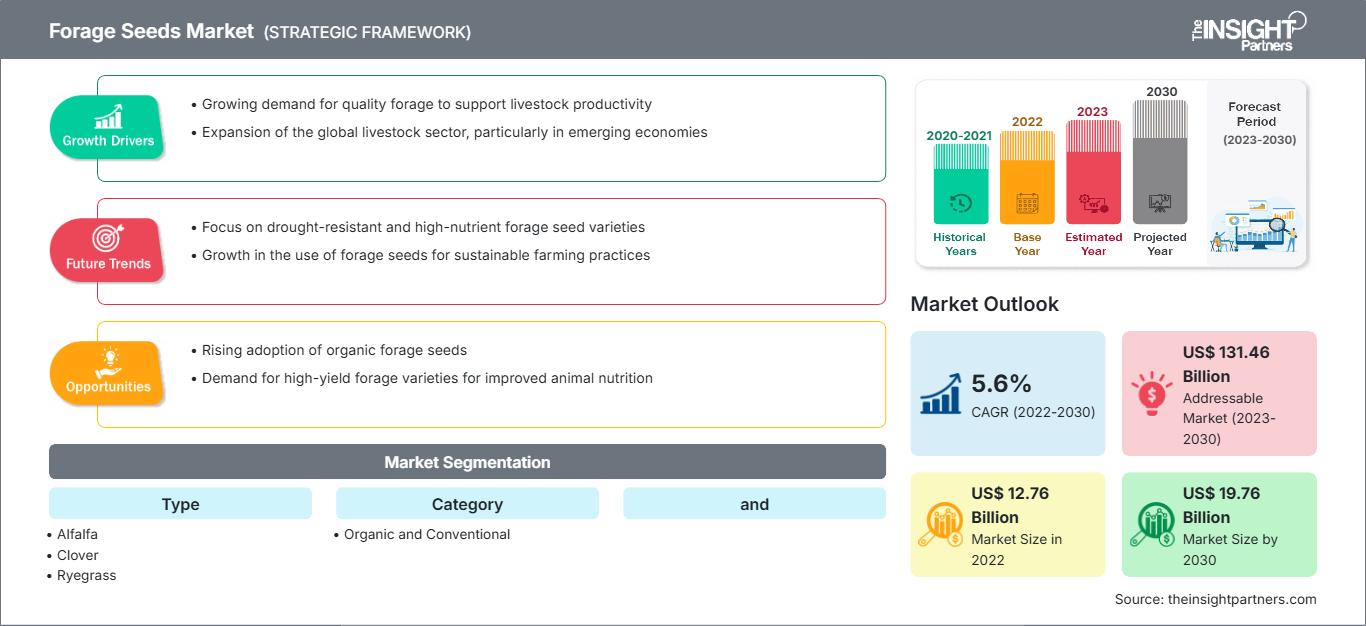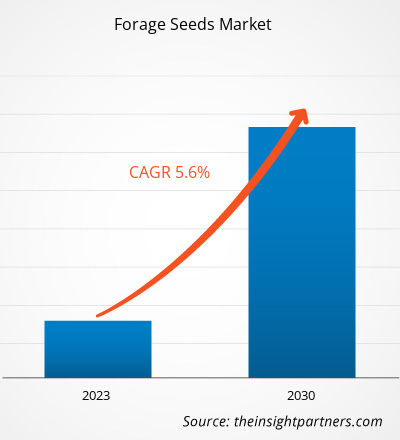[연구 보고서] 시장은 2022년 127억 5,700만 달러에서 2030년 197억 5,546만 달러로 성장할 것으로 예상되며, 2022년부터 2030년까지 연평균 성장률 5.6%를 기록할 것으로 예상됩니다.
시장 분석 및 분석가 의견:
기존 사료에는 가축이 섭취했을 때 육질을 저하시키는 다량의 화학 물질이 포함되어 있습니다. 이러한 육류 섭취는 장기적으로 다양한 건강 문제를 야기합니다. 이러한 문제를 해결하기 위해 제조업체들은 화학 첨가물이 없는 유기농 사료를 개발하고 있습니다. 이러한 사료를 섭취한 가축은 영양가가 높은 육류를 섭취할 수 있습니다. 따라서 소비자들은 유기농 및 천연 제품을 기존 제품보다 더 건강한 대안으로 생각하는 경향이 있습니다. 소비자들은 주로 유기농 제품을 선호하며, 이는 제조업체들이 유기농 성분으로 생산된 제품에 많은 투자를 하도록 유도했습니다. 더욱이, 인터넷의 도움으로 무한한 정보에 대한 접근성이 높아짐에 따라 소비자들은 건강 관리에 대한 필요성을 더욱 인식하게 되었고, 이는 유기 사료에 대한 수요 증가로 이어졌습니다. 따라서 예측 기간 동안 유기 사료에 대한 선호도 증가는 사료용 종자 시장의 중요한 트렌드가 될 것으로 예상됩니다.
성장 동력 및 과제:
종자 유전학의 기술적 발전은 세계 사료용 종자 시장 성장의 기회를 제공합니다. 종자 제조업체들은 기술 발전에 따라 잡종, GMO, 비GMO, 유기농 종자 등 다양한 품종이나 형질의 종자를 개발해 왔습니다. 잡초와 질병으로 인한 작물 손실을 최소화하고 종자의 품질을 향상시키기 위해 농부들은 이러한 유전자 변형 품종을 선호하며, 이는 다양한 사료 재배 지역에서 점차 증가하고 있습니다. 잡종 종자는 같은 종의 두 가지 다른 모식물을 특수하고 신중하게 제어된 교차 수분을 통해 개발되며, 이는 같은 식물 두 가지의 근친 교배로는 만들어낼 수 없는 새로운 형질을 생성합니다. 일반적으로 교배종 종자는 수작업으로 교차 수분됩니다.
GMO 종자는 생물체의 유전 물질을 변형하는 유전 공학을 통해 생산됩니다. GMO 종자는 현대 생명공학 기술을 사용하여 실험실에서 재배됩니다. 반면, 비GMO 종자는 수분을 통해 재배됩니다. 유기농 종자는 비GMO 종자로 간주됩니다. 유기농 종자는 살충제, 비료 또는 기타 화학 물질을 사용하지 않고 자연적으로 생산됩니다. 이러한 종자는 병충해에 강하고 악조건에서도 잘 자랄 수 있는 능력을 갖추고 있습니다.
이러한 육종 기술은 종자와 식물 세포의 DNA를 변형하여 원하는 특성을 가진 새로운 종자 품종을 개발할 수 있도록 합니다. 이러한 기술 발전은 농부들이 사료용 종자 재배 과정에서 직면하는 어려움을 해결하는 데 도움이 됩니다. 따라서 지속적인 기술 발전은 향후 사료용 종자 시장에서 수익성 있는 기회를 창출할 것으로 예상됩니다.
요구 사항에 맞게 이 보고서를 사용자 정의하십시오.
이 보고서의 일부, 국가 수준 분석, Excel 데이터 팩을 포함하여 모든 보고서에 대한 사용자 정의를 무료로 받을 수 있을 뿐만 아니라 스타트업 및 대학을 위한 훌륭한 제안 및 할인을 이용할 수 있습니다
사료 씨앗 시장: 전략적 통찰력

-
이 보고서의 주요 주요 시장 동향을 확인하세요.이 무료 샘플에는 시장 동향부터 추정 및 예측에 이르기까지 데이터 분석이 포함됩니다.
보고서 세분화 및 범위:
"세계 사료용 종자 시장"은 유형, 범주, 가축 및 지역을 기준으로 세분화됩니다. 유형별로 사료용 종자 시장은 [알팔파, 클로버(백색, 적색, 잡종 등), 라이그래스(일년생 라이그래스, 다년생 라이그래스, 이탈리안 라이그래스, 잡종 라이그래스), 티모시, 수수, 브롬, 버드풋 트레포일, 동부, 메도우 페스큐 등]으로 세분화됩니다. 범주별로는 유기농 및 관행농으로 세분화됩니다. 가축별로 사료용 종자 시장은 반추동물, 가금류, 돼지 등으로 세분화됩니다. 사료용 종자 시장은 지리적으로 북미(미국, 캐나다, 멕시코), 유럽(독일, 프랑스, 이탈리아, 영국, 러시아 및 기타 유럽), 아시아 태평양(호주, 중국, 일본, 인도, 한국 및 기타 아시아 태평양), 중동 및 아프리카(남아프리카, 사우디아라비아, UAE 및 기타 중동 및 아프리카), 남미 및 중미(브라질, 칠레 및 기타 남미 및 중미)로 세분화됩니다.
세분화 분석:
가축을 기준으로 사료용 종자 시장은 반추동물, 가금류, 돼지 및 기타로 세분화됩니다. 반추동물 부문은 2022년 사료용 종자 시장에서 가장 큰 점유율을 차지했으며 예측 기간 동안 상당한 성장률을 기록할 것으로 예상됩니다. 반추동물에는 소, 양, 염소 및 물소가 포함됩니다. 사료는 반추동물에게 단백질, 섬유질, 그리고 에너지의 주요 공급원입니다. 알팔파와 클로버 같은 콩과 식물 사료는 반추동물에게 필요한 조단백질의 75%를 공급합니다. 사료용 풀은 반추동물에게 다량의 섬유질을 제공합니다. 또한 사료는 반추위 사료의 전반적인 비용을 절감합니다. 따라서 가축 사육업자들은 일반적으로 사료와 함께 사료를 사용합니다. 특히 젖소, 염소, 양, 그리고 육우와 같은 반추동물의 특정 영양에 대한 인식이 높아짐에 따라 사료 수요가 증가하고 있으며, 이는 사료 종자 시장의 성장을 촉진하고 있습니다.
지역 분석:
지역별로 사료 종자 시장은 북미, 유럽, 아시아 태평양, 중남미, 그리고 중동 및 아프리카의 5개 주요 지역으로 구분됩니다. 글로벌 사료 씨앗 시장은 북미가 주도했으며 2022년에는 약 50억 달러 규모로 추산되었습니다. 북미는 사료로서의 사료 수요 증가, 육류 소비 및 기상 조건과 가격 상승에도 불구하고 가축 제품 소비 증가, 잘 확립된 동물 사료 및 농업 산업으로 인해 사료 씨앗의 중요한 시장 중 하나입니다. 단백질이 풍부하고 건강한 제품을 선택하는 개인이 증가하고, 가처분 소득이 증가하고, 라이프스타일이 변화하고, 식습관이 미국, 캐나다, 멕시코에서 단백질이 풍부한 육류에 대한 수요가 급증하는 데 기여합니다. 따라서 육류 제품 소비가 증가함에 따라 동물 사료에 대한 수요가 증가하고 사료 씨앗 시장을 더욱 촉진합니다. 이 지역은 이 지역에서 가장 큰 동물 사료 생산지 중 하나입니다. Alltech Global의 보고서에 따르면 2020년에 이 지역은 2억 5,400만 톤 이상의 동물 사료 제품을 생산했습니다. 북미 지역에서 가축 사료의 대량 생산과 육류 및 유제품에 대한 식품 안전 우려 증가로 인해 이 지역의 사료와 같은 영양가 있는 가축 사료 소비가 증가했습니다. 북미 지역의 축산업이 크게 증가함에 따라 예측 기간 동안 사료와 같은 가축 사료 수요도 증가할 것으로 예상됩니다. 예를 들어, 풋힐스 사료 및 방목 협회(Foothills Forage & Grazing Association)에 따르면, 2021년 7월 1일 기준 캐나다 소 사육두수는 1,229만 마리로 2020년 7월 1일 대비 0.2% 증가했습니다. 이러한 증가는 신선 육류 제품에 대한 수요 증가로 인해 소 수입이 급증했기 때문입니다. 또한, 미국 농무부(UDSA) 보고서에 따르면, 2021년 북미 지역의 소 사육두수는 1억 1,400만 마리를 넘어섰고, 돼지 사육두수는 1억 900만 마리를 넘어섰습니다. 따라서 가축의 수가 증가하고 건강한 가축 사료에 대한 수요가 증가함에 따라 이 지역 전체에서 사료용 씨앗에 대한 수요가 증가하고 있습니다.
산업 개발 및 미래 기회:
사료용 씨앗 시장에서 활동하는 주요 업체가 취한 다양한 이니셔티브는 아래와 같습니다.
- 2022년 11월, 지속 가능한 농업 솔루션의 글로벌 공급업체인 UPL Ltd.는 자사인 Advanta Seeds UK와 Bunge가 SEEDCORP|HO의 지분을 각각 20%씩 인수하기로 계약을 체결했다고 발표했습니다. 이번 투자는 UPL 그룹의 OpenAg 목표 달성을 위한 협력을 통해 농부들에게 완벽한 솔루션 패키지를 제공하기 위한 노력의 일환입니다.
- 2022년 10월, 글로벌 투자 회사인 KKR과 글로벌 농업 솔루션 제공업체인 UPL Limited는 KKR이 UPL Limited의 자회사인 Advanta Enterprises Limited의 지분 13.33%를 인수하기 위해 3억 달러를 투자하는 최종 계약 체결을 발표했습니다.
COVID-19의 영향:
COVID-19 팬데믹은 여러 국가의 경제와 산업에 영향을 미쳤습니다. 북미, 유럽, 아시아 태평양(APAC), 남미 및 중미(SAM), 중동 및 아프리카(MEA) 등 주요 국가에서 여행 금지, 봉쇄, 사업 중단 조치가 시행되면서 농업 및 사료 산업을 포함한 다양한 산업의 성장에 부정적인 영향을 미쳤습니다. 제조 시설 폐쇄는 전 세계 공급망, 배송 일정, 제조 활동, 그리고 다양한 필수 및 비필수 제품의 판매에 차질을 빚었습니다. 여러 기업들이 2020년 제품 배송 지연 및 향후 제품 판매 부진 가능성을 발표했습니다. 또한, 유럽, 아시아, 북미 여러 국가의 국제 여행 금지 조치로 인해 기업들은 협력 및 파트너십 계획을 일시적으로 중단해야 했습니다. 이러한 모든 요인들이 2020년과 2021년 초 동물 사료 산업에 악영향을 미쳤고, 결과적으로 사료용 씨앗 시장의 성장을 저해했습니다.
사료용 씨앗
사료용 씨앗 시장 지역별 통찰력The Insight Partners의 분석가들은 예측 기간 동안 사료용 씨앗 시장에 영향을 미치는 지역별 동향과 요인들을 면밀히 분석했습니다. 이 섹션에서는 북미, 유럽, 아시아 태평양, 중동 및 아프리카, 그리고 중남미 지역의 사료용 씨앗 시장 부문과 지역별 분포도 살펴봅니다.
사료용 씨앗 시장 보고서 범위
| 보고서 속성 | 세부 |
|---|---|
| 시장 규모 2022 | US$ 12.76 Billion |
| 시장규모별 2030 | US$ 19.76 Billion |
| 글로벌 CAGR (2022 - 2030) | 5.6% |
| 이전 데이터 | 2020-2021 |
| 예측 기간 | 2023-2030 |
| 다루는 세그먼트 |
By 유형
|
| 포함된 지역 및 국가 |
북미
|
| 시장 선도 기업 및 주요 회사 프로필 |
|
사료 씨앗 시장 참여자 밀도: 비즈니스 역학에 미치는 영향 이해
사료용 씨앗 시장은 소비자 선호도 변화, 기술 발전, 그리고 제품의 이점에 대한 인식 제고 등의 요인으로 최종 사용자 수요가 증가함에 따라 빠르게 성장하고 있습니다. 수요가 증가함에 따라 기업들은 제품 라인업을 확장하고, 소비자 니즈를 충족하기 위한 혁신을 추진하며, 새로운 트렌드를 적극 활용하고 있으며, 이는 시장 성장을 더욱 가속화하고 있습니다.

- 을 얻으세요 사료 씨앗 시장 주요 주요 플레이어 개요
경쟁 환경 및 주요 기업:
UPL Ltd, DLF Seeds AS, Corteva Inc, Limagrain UK Ltd, S&W Seed Co, Deutsche Saatveredelung AG, Cerience, Allied Seed LLC, MAS Seeds SA, Syngenta AG는 세계 사료용 종자 시장에서 활동하는 주요 기업입니다. 이러한 사료용 종자 제조업체는 혁신적인 기능을 갖춘 최첨단 종자 솔루션을 제공하여 농부와 가축에게 최상의 경험을 제공합니다.
- 과거 분석(2년), 기준 연도, CAGR을 포함한 예측(7년)
- PEST 및 SWOT 분석
- 시장 규모 가치/거래량 - 글로벌, 지역, 국가
- 산업 및 경쟁 환경
- Excel 데이터세트
최근 보고서
관련 보고서
사용 후기
구매 이유
- 정보에 기반한 의사 결정
- 시장 역학 이해
- 경쟁 분석
- 고객 인사이트
- 시장 예측
- 위험 완화
- 전략 기획
- 투자 타당성 분석
- 신흥 시장 파악
- 마케팅 전략 강화
- 운영 효율성 향상
- 규제 동향에 발맞춰 대응






















 무료 샘플 받기 - 사료 씨앗 시장
무료 샘플 받기 - 사료 씨앗 시장